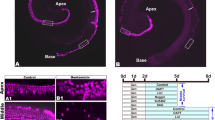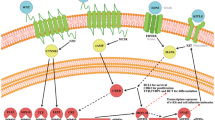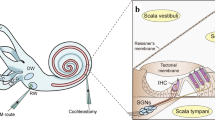Abstract
Hearing loss is a global health problem with profound socioeconomic impact. We contend that acquired hearing loss is mainly a modern disorder caused by man-made noise and modern drugs, among other causes. These factors, combined with increasing lifespan, have exposed a deficit in cochlear self-regeneration that was irrelevant for most of mammalian evolution. Nevertheless, the mammalian cochlea has evolved from phylogenetically older structures, which do have the capacity for self-repair. Moreover, nonmammalian vertebrates can regenerate auditory hair cells that restore sensory function. We will offer a critical perspective on recent advances in stem cell biology, gene therapy, cell cycle regulation and pharmacotherapeutics to define and validate regenerative medical interventions for mammalian hair cell loss. Although these advances are promising, we are only beginning to fully appreciate the complexity of the many challenges that lie ahead.
This is a preview of subscription content, access via your institution
Access options
Subscribe to this journal
Receive 12 print issues and online access
$209.00 per year
only $17.42 per issue
Buy this article
- Purchase on Springer Link
- Instant access to full article PDF
Prices may be subject to local taxes which are calculated during checkout


Similar content being viewed by others
References
Dallos, P., Billone, M.C., Durrant, J.D., Wang, C. & Raynor, S. Cochlear inner and outer hair cells: functional differences. Science 177, 356–358 (1972).
Merchant, S.N., Adams, J.C. & Nadol, J.B. Jr. Pathology and pathophysiology of idiopathic sudden sensorineural hearing loss. Otol. Neurotol. 26, 151–160 (2005).
Nadol, J.B. Jr. & Merchant, S.N. Histopathology and molecular genetics of hearing loss in the human. Int. J. Pediatr. Otorhinolaryngol. 61, 1–15 (2001).
Bhatt, K.A., Liberman, M.C. & Nadol, J.B. Jr. Morphometric analysis of age-related changes in the human basilar membrane. Ann. Otol. Rhinol. Laryngol. 110, 1147–1153 (2001).
Corwin, J.T. & Cotanche, D.A. Regeneration of sensory hair cells after acoustic trauma. Science 240, 1772–1774 (1988).
Ryals, B.M. & Rubel, E.W. Hair cell regeneration after acoustic trauma in adult Coturnix quail. Science 240, 1774–1776 (1988).
Hawkins, J.E. Jr., Johnsson, L.G., Stebbins, W.C., Moody, D.B. & Coombs, S.L. Hearing loss and cochlear pathology in monkeys after noise exposure. Acta Otolaryngol. (Stockh.) 81, 337–343 (1976).
Raphael, Y. & Altschuler, R.A. Reorganization of cytoskeletal and junctional proteins during cochlear hair cell degeneration. Cell Motil. Cytoskeleton 18, 215–227 (1991).
Warchol, M.E., Lambert, P.R., Goldstein, B.J., Forge, A. & Corwin, J.T. Regenerative proliferation in inner ear sensory epithelia from adult guinea pigs and humans. Science 259, 1619–1622 (1993).
Forge, A., Li, L., Corwin, J.T. & Nevill, G. Ultrastructural evidence for hair cell regeneration in the mammalian inner ear. Science 259, 1616–1619 (1993).
Leung, C.T., Coulombe, P.A. & Reed, R.R. Contribution of olfactory neural stem cells to tissue maintenance and regeneration. Nat. Neurosci. 10, 720–726 (2007).
Li, H., Liu, H. & Heller, S. Pluripotent stem cells from the adult mouse inner ear. Nat. Med. 9, 1293–1299 (2003).
Reynolds, B.A. & Rietze, R.L. Neural stem cells and neurospheres—re-evaluating the relationship. Nat. Methods 2, 333–336 (2005).
Hu, Z. & Corwin, J.T. Inner ear hair cells produced in vitro by a mesenchymal-to-epithelial transition. Proc. Natl. Acad. Sci. USA 104, 16675–16680 (2007).
Oshima, K. et al. Differential distribution of stem cells in the auditory and vestibular organs of the inner ear. J. Assoc. Res. Otolaryngol. 8, 18–31 (2007).
Savary, E. et al. Distinct population of hair cell progenitors can be isolated from the postnatal mouse cochlea using side population analysis. Stem Cells 25, 332–339 (2007).
Zhai, S. et al. Isolation and culture of hair cell progenitors from postnatal rat cochleae. J. Neurobiol. 65, 282–293 (2005).
White, P.M., Doetzlhofer, A., Lee, Y.S., Groves, A.K. & Segil, N. Mammalian cochlear supporting cells can divide and trans-differentiate into hair cells. Nature 441, 984–987 (2006).
Kawamoto, K., Ishimoto, S., Minoda, R., Brough, D.E. & Raphael, Y. Math1 gene transfer generates new cochlear hair cells in mature guinea pigs in vivo. J. Neurosci. 23, 4395–4400 (2003).
Izumikawa, M. et al. Auditory hair cell replacement and hearing improvement by Atoh1 gene therapy in deaf mammals. Nat. Med. 11, 271–276 (2005).
Lumpkin, E.A. et al. Math1-driven GFP expression in the developing nervous system of transgenic mice. Gene Expr. Patterns 3, 389–395 (2003).
Bermingham, N.A. et al. Math1: an essential gene for the generation of inner ear hair cells. Science 284, 1837–1841 (1999).
Woods, C., Montcouquiol, M. & Kelley, M.W. Math1 regulates development of the sensory epithelium in the mammalian cochlea. Nat. Neurosci. 7, 1310–1318 (2004).
Zheng, J.L. & Gao, W.Q. Overexpression of Math1 induces robust production of extra hair cells in postnatal rat inner ears. Nat. Neurosci. 3, 580–586 (2000).
Gubbels, S.P., Woessner, D.W., Mitchell, J.C., Ricci, A.J. & Brigande, J.V. Functional auditory hair cells produced in the mammalian cochlea by in utero gene transfer. Nature 455, 537–541 (2008).
Hayashi, T., Cunningham, D. & Bermingham-McDonogh, O. Loss of Fgfr3 leads to excess hair cell development in the mouse organ of Corti. Dev. Dyn. 236, 525–533 (2007).
Mansour, S.L. et al. Hearing loss in a mouse model of Muenke syndrome. Hum. Mol. Genet. 18, 43–50 (2009).
Brooker, R., Hozumi, K. & Lewis, J. Notch ligands with contrasting functions: Jagged1 and Delta1 in the mouse inner ear. Development 133, 1277–1286 (2006).
Daudet, N. et al. Notch regulation of progenitor cell behavior in quiescent and regenerating auditory epithelium of mature birds Dev. Biol. 326, 86–100 (2009).
Ma, E.Y., Rubel, E.W. & Raible, D.W. Notch signaling regulates the extent of hair cell regeneration in the zebrafish lateral line. J. Neurosci. 28, 2261–2273 (2008).
Yamamoto, N. et al. Inhibition of Notch/RBP-J signaling induces hair cell formation in neonate mouse cochleas. J. Mol. Med. 84, 37–45 (2006).
Takebayashi, S. et al. Multiple roles of Notch signaling in cochlear development. Dev. Biol. 307, 165–178 (2007).
Zine, A., Van De Water, T.R. & de Ribaupierre, F. Notch signaling regulates the pattern of auditory hair cell differentiation in mammals. Development 127, 3373–3383 (2000).
Hori, R. et al. Pharmacological inhibition of Notch signaling in the mature guinea pig cochlea. Neuroreport 18, 1911–1914 (2007).
Chen, P. & Segil, N. p27(Kip1) links cell proliferation to morphogenesis in the developing organ of Corti. Development 126, 1581–1590 (1999).
Lowenheim, H. et al. Gene disruption of p27(Kip1) allows cell proliferation in the postnatal and adult organ of Corti. Proc. Natl. Acad. Sci. USA 96, 4084–4088 (1999).
Mantela, J. et al. The retinoblastoma gene pathway regulates the postmitotic state of hair cells of the mouse inner ear. Development 132, 2377–2388 (2005).
Sage, C. et al. Proliferation of functional hair cells in vivo in the absence of the retinoblastoma protein. Science 307, 1114–1118 (2005).
Sage, C. et al. Essential role of retinoblastoma protein in mammalian hair cell development and hearing. Proc. Natl. Acad. Sci. USA 103, 7345–7350 (2006).
Weber, T. et al. Rapid cell-cycle reentry and cell death after acute inactivation of the retinoblastoma gene product in postnatal cochlear hair cells. Proc. Natl. Acad. Sci. USA 105, 781–785 (2008).
Heller, S. & Raphael, Y. Emerging strategies for restoring the cochlea. in Springer Handbook of Auditory Research vol. 31, Auditory Trauma, Protection, and Repair (Schacht, J., Popper, A.N. & Fay, R.R., eds.) 321–338 (Springer, New York, 2008).
Li, H., Roblin, G., Liu, H. & Heller, S. Generation of hair cells by stepwise differentiation of embryonic stem cells. Proc. Natl. Acad. Sci. USA 100, 13495–13500 (2003).
Nin, F. et al. The endocochlear potential depends on two K+ diffusion potentials and an electrical barrier in the stria vascularis of the inner ear. Proc. Natl. Acad. Sci. USA 105, 1751–1756 (2008).
Konishi, M., Kawamoto, K., Izumikawa, M., Kuriyama, H. & Yamashita, T. Gene transfer into guinea pig cochlea using adeno-associated virus vectors. J. Gene Med. 10, 610–618 (2008).
Chen, P. et al. Progressive hearing loss in mice lacking the cyclin-dependent kinase inhibitor Ink4d. Nat. Cell Biol. 5, 422–426 (2003).
Robles, L. & Ruggero, M.A. Mechanics of the mammalian cochlea. Physiol. Rev. 81, 1305–1352 (2001).
Richter, C.P., Emadi, G., Getnick, G., Quesnel, A. & Dallos, P. Tectorial membrane stiffness gradients. Biophys. J. 93, 2265–2276 (2007).
Russell, I.J. et al. Sharpened cochlear tuning in a mouse with a genetically modified tectorial membrane. Nat. Neurosci. 10, 215–223 (2007).
Flock, A. & Strelioff, D. Graded and nonlinear mechanical properties of sensory hairs in the mammalian hearing organ. Nature 310, 597–599 (1984).
Ricci, A.J., Crawford, A.C. & Fettiplace, R. Tonotopic variation in the conductance of the hair cell mechanotransducer channel. Neuron 40, 983–990 (2003).
Acknowledgements
We gratefully acknowledge support by the US National Institutes of Health (DC008595 to J.V.B. and DC06167 to S.H.), the McKnight Endowment Fund for Neuroscience (J.V.B. and S.H.) and the California Institute for Regenerative Medicine (RC1-00119 to S.H.).
Author information
Authors and Affiliations
Corresponding author
Rights and permissions
About this article
Cite this article
Brigande, J., Heller, S. Quo vadis, hair cell regeneration?. Nat Neurosci 12, 679–685 (2009). https://doi.org/10.1038/nn.2311
Published:
Issue Date:
DOI: https://doi.org/10.1038/nn.2311
This article is cited by
-
Animal models to study cardiac regeneration
Nature Reviews Cardiology (2024)
-
Revealing the contribution of basilar membrane’s biological activity to the mechanism of the cochlear phonosensitive amplification
Applied Mathematics and Mechanics (2023)
-
Glucose Protects Cochlear Hair Cells Against Oxidative Stress and Attenuates Noise-Induced Hearing Loss in Mice
Neuroscience Bulletin (2021)
-
Reaktionen im Corti-Organ auf elektrische Stimulation
HNO (2019)
-
Strategien für eine regenerative Therapie der Schwerhörigkeit
HNO (2018)



